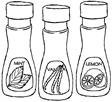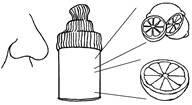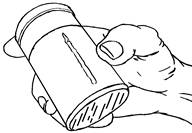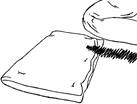renewal cycles. Complete
some now & some later.
and Get 25% off
the Total price!
Buy 3 Courses
and Get 30% off
the Total price!
Buy 4 Courses
and Get 35% off
the Total price!
| Create Account | Login | |

Section 12
Sensory Stimulation
Table of Contents | NCCAP/NCTRC CE Booklet
Scent, Sound, and Kneeling Pad
To Awaken or Not to Awaken?
Before I discuss Scent Therapy in detail, I would like to address the topic of whether or not to awaken a sleeping resident. I have stated and will continue to state to always be aware of the resident's preferences. However, it becomes a judgment call whether you waken a sleeping resident or not. If the resident is alert, clearly he or she has the right to take a nap when he or she feels like it. However, some of our heavy-care, disoriented, unresponsive residents could “sleep their lives away.” Do you agree? I feel that your waking a resident is appropriate if you feel that the resident has the ability to be more alert, but is simply caught in a continual semi-slumbering state. I feel that using a sensory stimulation activity, like Scent Therapy, mentioned in the following sections as an introductory activity, is sometimes appropriate to bring the resident to a more alert state.

Scent Therapy
Scent Therapy is referenced regarding an increase of your resident's awareness of a Mobile and as a means to gain a focused eye contact from the resident. Let's talk about Scent Therapy in further detail now. Materials for Scent Therapy can include, but are not limited to, vanilla, mint and/or lemon extracts and cotton balls.
If you have the resident smell from the bottle, and the resident becomes startled, he or she may knock the extract bottle out of your hand. You may learn rather quickly, like I did, to have your resident smell the extract from the cap of the extract bottle or from a cotton ball, rather than from the full bottle itself. Also, if you know that a resident has a habit of swatting out at the person who is speaking, you might have your left hand ready to gently block his or her aggression. This might be a good point to include in volunteer and new staff training regarding working with that resident. However, if the resident is swatting you away when presented with a scent, this, of course, may be the resident's way of communicating displeasure. Obviously, the activity should immediately be re-evaluated for its appropriateness with that particular resident at that particular time on that particular day.
To introduce the extract, for example, you might say:
 - "Fannie, I’ve got something for you to smell here. Would you like to smell something for me?"
- "Fannie, I’ve got something for you to smell here. Would you like to smell something for me?"
- Gradually bring the cotton ball or cap with the scent close to the resident's nose.
- Assess what is the furthest distance at which your Fannie can smell the scent, rather than putting it directly under her nose immediately.
- Now, assess your Fannie’s reaction. Sometimes residents will pull their heads back.
- Ask yourself, "Is she indicating a negative response? Perhaps this activity should not be tried again."
- However, sometimes the resident will smile or have a more focused look on her face. You might interpret this as being a positive experience for your Fannie.
Your Goal could be written based upon the type of reaction your Fannie displays. So, notice what she does, and that can become the basis of your Care Plan.
Goal: To move head in response to a scent… |
Goal: To open eyes in response to a scent… |
Goal: To have eye contact after smelling a scent… |
Goal: To make a Noise such as "ah-ah" after smelling a scent… |
Goal: To use the word "you," "Martha," or "sister" after smelling a scent… |
Goal: To carry on a simple, one-word conversation after smelling a scent… |
Residents with whom to try Scent Therapy
Resident |
Who will gather materials and/or construct project? |
Staff /Volunteer to work with residents? When? |
|
|
|
|
|
|
|
|
|
Smell Can
(The last track of the DVD contains a slide illustrating implementation of this activity with a resident.)
 Here is another form of Scent Therapy. Even though this is an activity for a much more alert resident, it seemed appropriate to introduce in with Scent Therapy. I realize you probably do not have many extremely alert residents in your facility, but occasionally you may get a resident who is perhaps recovering from a stroke or surgery, and may be fairly alert. As you are aware, after a time, these alert residents can become disoriented due to sheer lack of stimulation. So the smell can might help to keep your alert residents mentally stimulated.
Here is another form of Scent Therapy. Even though this is an activity for a much more alert resident, it seemed appropriate to introduce in with Scent Therapy. I realize you probably do not have many extremely alert residents in your facility, but occasionally you may get a resident who is perhaps recovering from a stroke or surgery, and may be fairly alert. As you are aware, after a time, these alert residents can become disoriented due to sheer lack of stimulation. So the smell can might help to keep your alert residents mentally stimulated.
Of course, the smell cans can be used in a group or individually. So you might consider making a Guess Game out the smell can. Here’s how it works. Get a small, empty can, such as a coffee can. This is a good size for the resident to hold. Then cut the ribbing off of the top of a man’s sock. Discard the foot part so that you are left with only the tubular ribbing of the sock. Wash the can, of course, to remove any coffee smell. However, later you could wrap a couple of tablespoons of coffee in a paper towel or thin cloth and the resident could try to guess that smell. After the can is washed, slide the tubular sock top over the coffee can. You might cover the outside of your smell can with construction paper taped to the can or glue with Elmer’s Glue. The words "Smell Can" might be printed in black marker. Then cover the can with clear contact paper, so it can easily be wiped clean.
Various items to place in your smell can might be an orange slice, a lemon slice, an apple slice, or even an onion. You might make this decision depending on what dietary happens to have handy.
As you are probably aware, smell cans make good topics of conversation in a Reminiscence Group. If you have something liquid, like an extract (for example, strawberry extract or a perfume), you might put the liquid on a cotton ball, as suggested in the previous section. Also, this is a great activity for a volunteer to conduct, because your volunteers can bring in items for their smell can discussions. After trying to guess the smell, conversations might focus on recipes, holidays and events. Oftentimes the smell of oranges, as you know, reminds residents of Christmas, because fruit was usually scarce at Christmas time and was a special treat.
| Problem: Starting to become disoriented regarding events in the past, present, and future… Goal: To guess the scent in the smell can and to discuss memories in a Reminiscence Group weekly… |
Goal: To correctly guess the scent in the can one out of three times…. |
Residents with whom to try the Smell Can
Resident |
Who will gather materials and/or construct project? |
Staff /Volunteer to work with resident(s)? When? |
|
|
|
|
|
|
|
|
|

React to a Sound
Let’s switch the focus back to your lower-functioning residents now. For residents who do not react to a smell, you might see if the resident can react to a Sound. For example, use a bouillon cube container with rice in it. Bouillon cube containers are a good size. The rice makes a pleasant rattling Sound against the bottom of the container. Tape the plastic top onto the bouillon cube container, so it cannot be easily removed by the resident. Gently rattle the container about 3 or 4 inches from the resident's ear. You might say something like, "Mary, I’ve got something here for you to listen to," and then rattle the container. Then comment, "What do you think this is? What does this sound like to you? Can you turn your head in this direction?" Of course for an extremely disoriented resident, your questions are a monologue. If Mary is sitting with her head to the left, you would make a point to move the Sound to Mary's right to encourage her to turn her head to the right.
| Goal: To turn head in direction of Sound… Approach: Hold container making Sound about 3 or 4 inches from the resident’s ear… Approach: To encourage Mary to turn her head by making a gentle Noise with container of rice on the opposite side to which her head is turned… Approach: To ask resident as container is rattled “Can you turn your head in this direction?.." |
Goal: To open eyes… To open eyes wider… To have eye contact… To make a Noise… To say a word in responseto a Sound…etc… |
Residents with whom to try Bouillon Cube Container with Rice
Resident |
Who will gather materials and/or construct project? |
Staff /Volunteer to work with resident? When? |
|
|
|
|
|
|
|
|
|
Culture Change Implementation: Place Bouillon Cube Container in labeled Activity Project Bag left in resident’s room for CNA, etc. use.
A “Sound” Success Story
(The last track of the DVD that accompanied this Course contains slide(s) illustrating implementation of this activity.)
Here's a success I experienced by using Sound in a different way. When I was an Activity Director, there was one total-care resident, Cecil, who was completely contractured in his arms and legs. Cecil wasn’t able to talk, but he was fairly alert. Cecil communicated by closing and opening his eyes. His bed-bound condition always made him a favorite for CMS Surveyor’s in-depth reviews. In meeting the challenge of creating an activity program for Cecil, I discovered from his family that he loved a religious song called “Fly Away.” However, because of his physical rigidity, he was mostly bed-bound. I had a local church group, when they were visiting the facility for their weekly sing-along, record Cecil's favorite song, “Fly Away,” several times into a tape recorder. Listening to the tape of "Fly Away" became part of Cecil's activity program. Also, I was lucky enough to have an alert, ambulatory, good-natured male resident (I know… they are hard to find!) to bring the tape player into his room regularly.
Individualized Music Therapy Program.
Here’s a challenge for you… When you interview your next new admission who is alert enough to communicate past interests, you might file this idea away in the back of your mind, if he or she expresses a particularly strong preference for a specific song. Even though you may not have the musical ability to play the song on a piano or guitar, consider approaching a musical volunteer group that comes into your facility regarding tape-recording that specific song or songs for this Individualized Music Therapy Program. Here is a portion of Cecil's Care Plan.
Approach: To provide Cecil with tape player and music of his favorite religious song…
Residents with whom to try an Individualized Music Therapy Program
| Resident | Who will gather materials and/or construct project? |
Staff /Volunteer to work with resident? When? |
|
|
|
|
|
|
Culture Change Implementation: Place Music Therapy tape in labeled Activity Project Bag left in resident’s room for CNA, etc. use.

Kneeling Pad
Clearly, as mentioned several times in this Manual, it is important to get eye contact with and be at the eye-level of your resident. If you have a hard time bending down or squatting down for any length of time, as I do, you may want to make a kneeling pad. You have probably noticed my use of the kneeling pad on the DVD. If you did not notice my kneeling, you might replay the DVD to see that kneeling while talking to a resident is not as strange as it  may seem, if you haven't done it before.
may seem, if you haven't done it before.
Should you wish to make your own kneeling pad, consider going to a carpet dealer and buying scrap pieces of the thickest carpet pad they have. Fold the foam carpet pad into quarters, and staple it in place. The size of my kneeling pad is about 7 inches by 15 inches, but make it the best size that suits you. The point of the kneeling pad, of course, is that you can use this to kneel on while working with residents to make eye contact with them. You are probably aware that you can buy kneeling pads in gardening shops. However, I have not had very much success with the kneeling pads found in garden shops. These pads tend to be hard, non-flexible and tend to break easily. If you can find a flexible foam one, though, that is great.
However, if kneeling isn't your thing, discount stores like Wal-Mart may carry small folding chairs or stools in their furniture departments. Usually, these can be found in the autumn when back-to-school dorm room furniture is well-stocked.
Why do you need a pad, folding stool, or folding chair?
Let me back up a minute, just in case this is your first day on the job; residents are usually sitting in the hall or in locations where there is not a chair close by. By the time you transport a disoriented resident to a seat intended for you, not only have you lost a lot of time, in light of the 10 or 20 One-to-One Activities you have scheduled for that morning, but the resident may become "upset" due to this move. Also, by the time you get him or her to a convenient location where you can sit next to them in a nice comfy chair, you may not be able to work with your Millie due to her now agitated state, caused by the relocation. Do you have residents that become agitated when they are relocated? So, if you were scratching you head thinking, "What do I need a kneeling pad or folding stool for?", now you know.
Residents with whom to try use of a Kneeling Pad or Folding Chair/Stool
Resident |
Who will purchase/construct item? |
Staff /Volunteer to work with resident? When? |
|
|
|
|
|
|
|
|
|
|
|
|
NCCAP/NCTRC CE Booklet
Forward to Section 13
Back to Section 11
Table of Contents
Top


